Japanese Cooking 101, Lesson 1: How to make dashi stock, the foundation of Japanese cooking
Welcome to the first lesson of Japanese Cooking 101! Throughout this course I hope to teach you about the foundations of traditional Japanese cooking or washoku (和食), as well as how to cook some Japanese dishes. So let's get started!
Lesson 1: Dashi
Dashi or stock (often called dashi stock, which is kind of redundant) is the foundation of all savory washoku. It's not just used in soups; it's used in everything, from sauces, dressings, as a liquid when stewing vegetables, and more. Without dashi, your Japanese dishes simply aren't right. If anything, dashi is more critical to Japanese cooking than meat, vegetable and fish stocks are to French cooking.
So what is dashi? Basically it is a liquid that is packed with umami, or glutamates. Umami is an essential part of any savory cuisine, but particularly so in Japanese cooking. It's not at all surprising that it was a Japanese scientist who invented the purest chemical form of umami, monosodium glutamate (MSG).
While using MSG or a instant dashi powder or granules is very handy, and although the quality of dashi powders have have improved in recent years, dashi made from time-tested, natural ingredients is more rounded and better tasting. The difference between dashi made from instant powder and one made from scratch is like the difference between a bouillon you make with a stock cube and one you make by simmering bones and vegetables for hours.
Luckily for us, the Japanese of yore came up with ways to make whipping up a batch of dashi very easy. Various dried ingredients, mostly from the sea, which can be kept without refrigeration, are used to make dashi quite easily - so much easier than making a meat stock. (I mean, dealing with those icky greasy bones after making chicken or beef stock is not nice.)
Main dashi ingredients
Dashi is made from one or two of these ingredients:
昆布 (kanji); こんぶ (hiragana): Kombu (or konbu) -seaweed
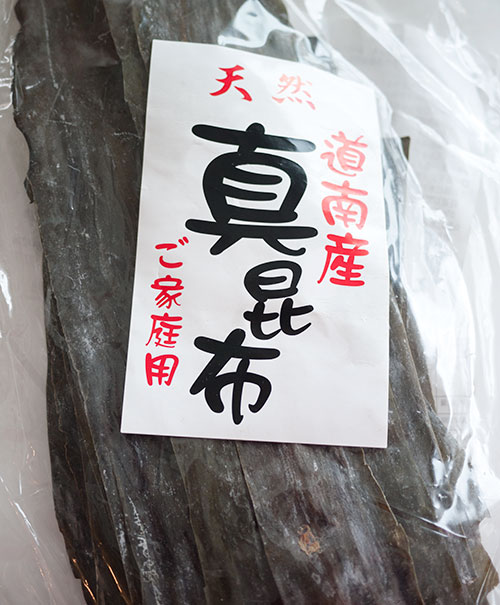
kombu seaweed is a slightly leathery seaweed. It may come in wide sheets, or long ropey strands. kombu is the most widely used dashi ingredient, and has the most neutral flavor of them all. If you are a vegan, a pure kombu dashi is an all-purpose, neutral tasting dashi.
Good kombu is covered on the surface with a fine white powdery substance. Do not wash this off - it's not caked on salt or dust! It's full of that umami we want to extract.
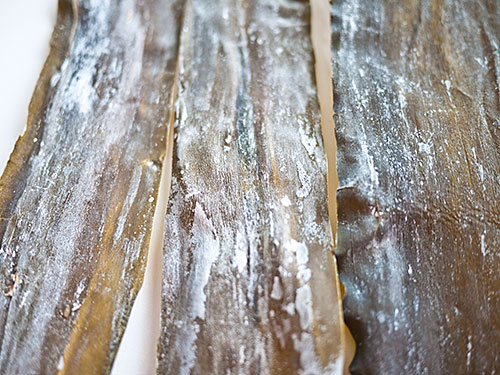
(Note: Many Japanese cookbooks instruct you to wipe the dirt off the surface of kombu with a tightly wrung out kitchen towel. The truth is, this really isn't necessary in most cases these days, since the kombu we get has already been cleaned very well. If you happen to get a batch with some gritty stuff on the surface you'll need to wipe it off, but make sure you're not getting rid of that powdery white stuff in the meantime. If a tiny bit of grit does make it into your dashi you can always strain it off later.)
鰹節 or かつお節 or かつおぶし: Katsuobushi, or bonito flakes
Also called kezuribushi or okaka.

Katsuobushi is a bonito fish (katsuo) that has been dried and fermenented to develop a lot of umami. The fish shrinks down and hardens until it's like a block of wood. This is then grated or shaved into thin flakes, rather like wood shavings. The shavings are used in cooking. Good, fresh pre-shaved katsuobushi is fluffy and yellowish-beige in color with a hint of blush pink. Katsuobushi is the second most common dashi ingredient after kombu. Most of the dashi used around the country in restaurants uses a combination of kombu and katsuobushi.
Katsuobushi is usually available in flaked form, although you can get a whole katsuobushi and a special box grater and grate your own. While freshly shaved or grated katsuobushi is very flavorful, it's a pain in the ass to grate manually, so most people, including professional cooks, use the pre-shaved stuff. (I've seen some electric katsuobushi-shavers sold in Japan, but they're pretty expensive.)
Other dashi ingredients used
We won't be using these ingredients for this lesson, but these items are used in dashi too.
- Small dried fish such as nishin or iwashi (にしん, いわし: herrings and sardines) are often used instead of katsuobushi. Some regions of the country prefer them over katsuobushi, and some people just use them because they are cheaper. The dashi made with these don't taste overly fishy, but are a bit more fishy than katsuobushi.
- Dried shiitake mushrooms (干し椎茸) are used for dashi on occasion. The soaking liquid from reconstituting dried mushrooms makes a very strong tasting dashi, which can be used on its own or with kombu dashi.
Ichiban dashi (first dashi) and niban dashi (second dashi)
Simply put, ichiban dashi or first dashi is the dashi you make from fresh (as in previously unused) ingredients kombu and katsuobushi. Niban dashi or second dashi is dashi made from the kombu, katsuobushi and so on that has previously been used for making ichiban dashi. Ichiban dashi is used for things like soups, or when you want the maximum amount of umami possible. Niban dashi is used for things like stewed dishes, when other ingredients like meat and vegetables will add more umami to the dish so a subtler dashi is adequate. Niban dashi is really a way of being frugal with your dashi ingredients.
Let's make some dashi!
In this lesson we will be making a standard ichiban (first) kombu and katsuobushi dashi, but I'll also show you how kombu-only dashi is made.
Long time readers of the site may know that I've given you a couple of different ways of making dashi in the past. They all work well, but here I'll walk you through the method that I think makes the best tasting dashi.
We will making 1 litre, or about 4 U.S. cups of dashi. For this you will need:
- 10 to 15 grams (1/3 to 1/2 ounce) of kombu
- 10 to 15 grams (1/3 to 1/2 ounce) of katsuobushi
- 1 litre or 1000 ml / 4 U.S. cups of water plus a bit of extra water (about 100ml or 1/3 cup) to allow for evaporation during cooking
The ratio of water to ingredients: Allow for a minimum of 10 grams of kombu, and 10 to 15 grams of katsuobushi, per 1000 ml(1l) or 4 U.S. sized cups of water. If you're making a kombu-only dashi, you'll want to use at least 15 grams. If you don't have a fairly precise scale, 10 grams of kombu is about a 4 inch square piece - which is the advice I've given you previously, and 19-15 grams of katsuobushi is a good handful. Here I used 15 grams of each. If you don't get the amounts precise don't worry; since these are all-natural ingredients, you can't really use too much of it.
Here's 15 grams of kombu. - about 1 1/2 4-inch / 10 cm squares.

And here's 15 grams of katuobushi - a generous handful:
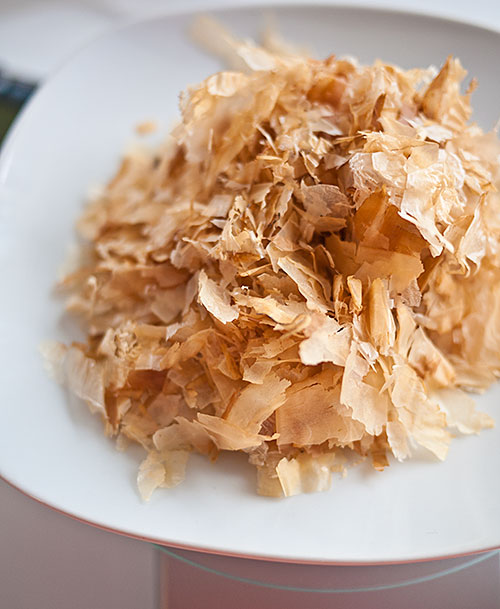
Set aside the katsuobushi. Put the kombu and water in a pan and leave it to soak for at least 30 minutes. You can leave it in the water for up to a day in the refrigerator, if you want to do the soaking step in advance.
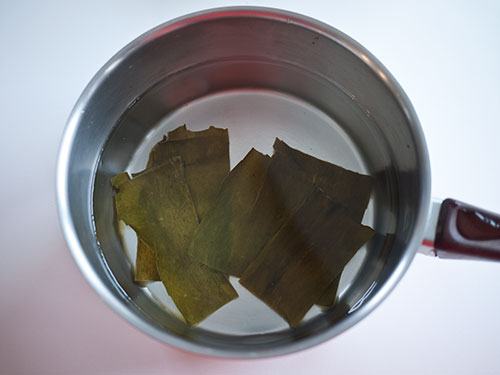
If you want to track how the dashi progresses, take a small sip of the liquid after the kombu has been soaking in it for a while. You should taste just a hint of the sea already. The surface of the kombu will have turned a bit slippery.
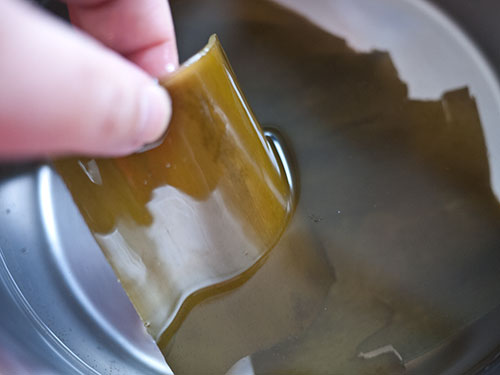
Put the pan on the hob and turn up the heat. Bring it to a boil, then lower the heat.
If you are making a kombu-only dashi, keep the pan on a barely-there low simmer for 30 minutes. Check the water level and add a bit more if it seems to be evaporating too fast.
IF you are making a kombu-katsuobushi combination dashi, simmer the kombu for 10 minutes, then turn off the heat.
Again, if you want to track the progress of the dashi, taste it at the 5, 10 and (if you're going for kombu-only dashi) the 30 minute stages. You'll notice that the dashi is getting gradually stronger in flavor, tasting like the sea. You should notice the umami even at the 5 minute mark. Kombu-only dashi barely has any color.
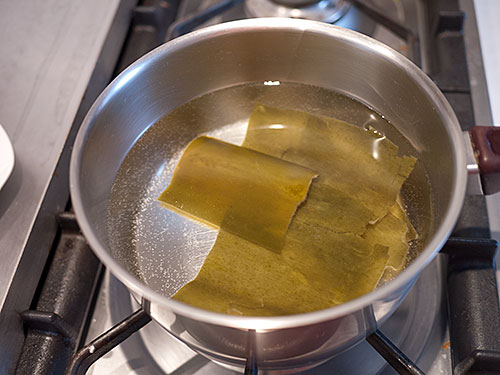
To make a kombu-katsuobushi combo dashi: After 10 minutes of simmering, add the katsuobushi, and turn the heat off.
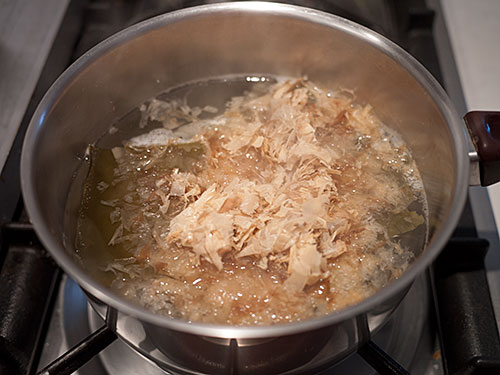
Let the pan sit for a few minutes (about 10 minutes) until the katsuobushi sinks to the bottom of the pan.
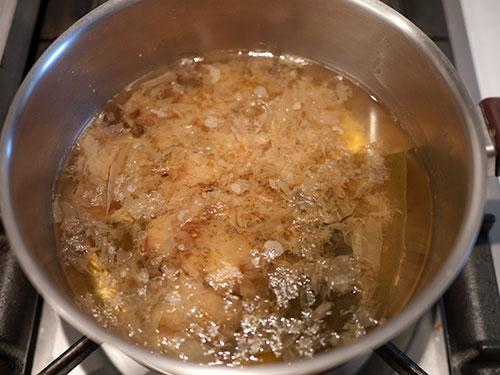
Strain off the liquid, using a fine-mesh sieve.
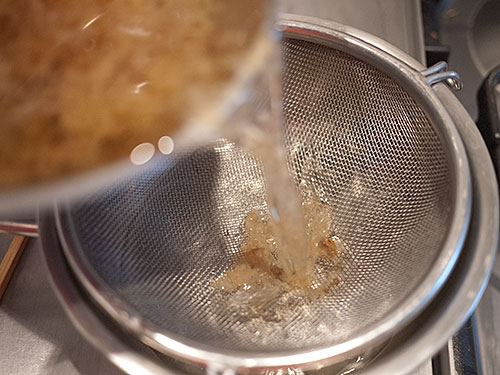
Don't throw away the used kombu and katsuobushi! We'll be using that in a later lesson, so put it in a plastic bag and store it in the freezer.
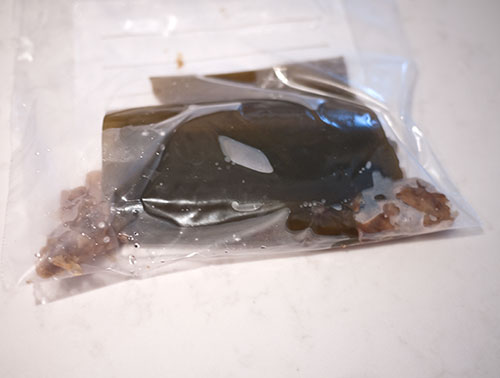
The dashi will have a pale golden color. Give it a taste - you'll notice the katuobushi, but it won't be unpleasantly 'fishy'; it will be like a very light bouillon without the salt.
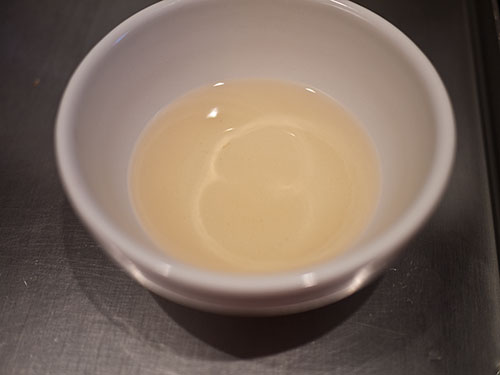
At this point the dashi can be used right away, or stored well covered for a few day in the refrigerator. You can also freeze it - putting it in ice cube trays is a handy way of doing this.
_This pale golden liquid is the foundation for your savory Japanese dishes. Master the art of dashi making and you're well on your way to becoming a Japanese Iron Chef!
Tomorrow I'll show you how to turn this dashi into two kinds of soup: clear soup called osumashi or osuimono, and misoshiru or miso soup.
Addendum: Using instant dashi stock granules
While dashi made from natural ingredients tastes the best, it may be difficult of not impossible to get the raw ingredients like kombu seaweed and katsuobushi in some parts of the world. In that case using instant dashi stock granules is fine, and certainly better than using straight MSG or nothing at all. And to be brutal, most Japanese restaurants around the world do not make dashi from scratch; they use the granules, (Once you know the taste of 'real' dashi, you'll soon be able to tell when a restaurant isn't using it.)
A complaint I hear sometimes about dashi made from dashi granules is that it is 'fishy'. While they do have some fish flavor (and the granules themselves, especially certain brands, can smell rather fishy) since they are made from katuobushi extract and such, I suspect that one problem is that people are using far too much of it. You only need to use about 1 teaspoon per 4 cups (1 liter) of water, or 1/4 teaspoon per cup.
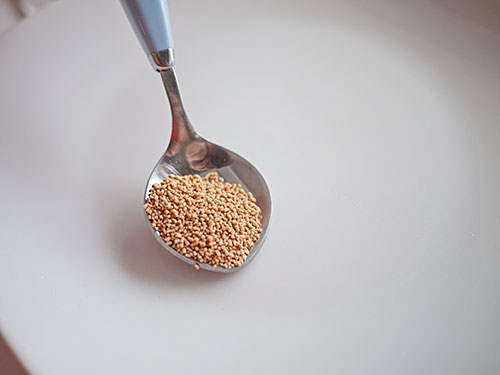
Dashi, whether made from granules or from scratch, is not meant to be used on its own; it is meant to be a flavor enhancer, not the entire flavor. You add other ingredients like salt, soy sauce, sake and so on to the dashi to "complete" the flavors. So trying to make add enough dashi granules to water or other liquid to make it 'strong' will not turn out well at all.
When you use dashi granules start with a small amount, add the other flavors and then add a bit more if you think it really needs it. Tasting as you go along is the best way to cook something you're unfamiliar with.
Dashi granules that come in pre-portioned packages like these are handy if you can't remember the dosage. These little sealed packages tend to keep better too.
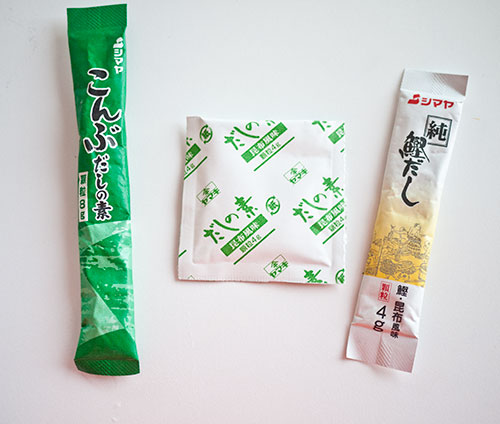
But again, if you can get the real ingredients, please try to make dashi the proper way at least once, so you can know what it's supposed to taste like.


 Welcome to Just Hungry, where we serve authentic Japanese recipes and more! I'm
Welcome to Just Hungry, where we serve authentic Japanese recipes and more! I'm 














Comments
spicytofu
6 March, 2013 - 05:33
Permalink
Re: Japanese Cooking 101, Lesson 1: It's All About the ...
Very cool! I have been waiting to learn how to make this stuff for a long time. I am so glad you have the directions step by step for our understanding. Thank you so much!
amehrman
6 March, 2013 - 05:41
Permalink
Re: Japanese Cooking 101, Lesson 1: It's All About the ...
Thank you this is a great explanation of dash. Wish I were still in Tokyo where these ingredients are so much easier to find. Looking forward to this cooking series.
Chiaoli
6 March, 2013 - 06:31
Permalink
Re: Japanese Cooking 101, Lesson 1: It's All About the ...
hi Maki,
thank you so much for this lesson!
one question! if I leave the katsuobushi longer in the stock, will the dashi produce stronger flavor?
thank you! --Chiaoli
maki
6 March, 2013 - 16:06
Permalink
Re: Japanese Cooking 101, Lesson 1: It's All About the ...
It will get stronger in flavor to some extent but never *too* flavored or anything. The only way to make a dashi really strong in flavor with katsuobushi is to just stuff the water with as much katsuobushi as will fit. On the original Iron Chef program in Japan, one of the Japanese Iron Chefs used to do that by putting in like 4 handfuls or so of katsuobushi in a small pan of water.
Chiaoli
7 March, 2013 - 07:55
Permalink
Re: Japanese Cooking 101, Lesson 1: It's All About the ...
Thank you! I've already made some, and it tasted VERY good, even though I don't think the quality of the konbu that I bought here was any good. It didn't have much of the "white stuff" on the surface. But the dashi still turned out great!
Kiliman
7 March, 2013 - 16:57
Permalink
Re: Japanese Cooking 101, Lesson 1: It's All About the ...
Yes, it was Rokusaburo Michiba and his "Broth of Vigor" ("Inochi no Dashi")
Great lesson BTW.
maki
7 March, 2013 - 17:17
Permalink
Re: Japanese Cooking 101, Lesson 1: It's All About the ...
Yep, Michiba-san is my all time favorite Iron Chef!
Chiaoli
7 March, 2013 - 20:17
Permalink
Re: Japanese Cooking 101, Lesson 1: It's All About the ...
After reading this blog entry and your replies, I've discovered this: Putting more katsuobushi, instead of cooking longer time, would add more flavor to the dashi . However, simmering konbu for a longer time (30mins) would add more flavor to the dashi. Am I right, Maki?
PS, You are fabulous!
maki
7 March, 2013 - 23:43
Permalink
Re: Japanese Cooking 101, Lesson 1: It's All About the ...
You've got it Chiaoli! Some people like a strong katsuobushi flavor, while others don't, so it's up to each cook to find out the best balance for his/her tastes. I personally do not like a very strong katsuobushi flavor, so I do the kombu-simmering part but don't overload the pot with katsuobushi.
dracuella
6 March, 2013 - 11:28
Permalink
Re: Japanese Cooking 101, Lesson 1: It's All About the ...
I think this Washoku 101 is just fantastic! Having cooked basic Japanese dishes for some time now, I've made dashi from scratch before but I'm still learning a lot about different views on what is the 'proper' way of doing it.
For instance, I've been told to remove (after soaking for 30 mins) the kombu before the water reaches boiling, then add katsuobushi and bring to a boil for several minutes.
And it's not just dashi; basically anything Japanese has ten accepted ways of making, so I'm working hard to try to find the ones I prefer myself.
I'm definitely going to try the katsuobushi soaking instead to see if this changes the flavour in some way.
John Böttcher
6 March, 2013 - 20:13
Permalink
Re: Japanese Cooking 101, Lesson 1: It's All About the ...
I'm also confused about this.
I have been told one must slowly bring the konbu to near boiling, take off the heat then chuck in ice cubes/very cold water to stop the boiling then remove the konbu, else the dash is spoilt.
So should I simmer the konbu or not?
maki
6 March, 2013 - 23:28
Permalink
Re: Japanese Cooking 101, Lesson 1: It's All About the ...
Good question, re: simmering the kombu. I've been inconsistent in this myself to be honest - in previous old posts, I've recommended taking the kombu out when the water gets to a boil. However, I have discovered - as have others - that a bit of simmering adds more flavor, and even a subtle sweetness, to the dashi. The NHK popular science program Tameshite Gatten! (Try it out, and get it!) did some tests with this and they came to that conclusion also. For kombu-only dashi in particular I was kind of shocked at the 30 minute simmer time, but it turns out it produces a really delicous and intense kombu dashi. Try it out and see what you think!
John Böttcher
7 March, 2013 - 02:29
Permalink
Re: Japanese Cooking 101, Lesson 1: It's All About the ...
Thank you Maki!
I've been using the method described in the "Dashi and Umami" book for a wee while, and also following youtube videos.
I have dashi t-bag style stuff (with no added MSG) - would you recommend simmering one for a while?
Regards
maki
7 March, 2013 - 17:19
Permalink
Re: Japanese Cooking 101, Lesson 1: It's All About the ...
The dashi teabags can be simmered for a few minutes. They mostly seem to contain katsuobushi or niboshi or iriko (another kind of dried fish) though so those flavors will become more prominent over the kombu, the longer you simmer them. It depends a bit on the brand though - try out different times and see what works best. Just start tasting as soon as you put it in, after a minute, etc. and stop when it tastes just right.
Annie
6 March, 2013 - 13:32
Permalink
Re: Japanese Cooking 101, Lesson 1: It's All About the ...
Great explanation. Thank you. I have been trying to incorporate more Japanese cooking into my family's daily life because it is just so good for us - as well as tasting great of course! This will help no end as homestyle cooking is what I'm aiming for ...and it's difficult to learn that without growing up in a Japanese home! I'm excited!
Kate
6 March, 2013 - 13:47
Permalink
Re: Japanese Cooking 101, Lesson 1: It's All About the ...
I've read some articles dissuading from consuming MSG since it's bad to our health. On the other hand, I see it's a common ingredient in the Asian cuisine.
Can I omit it while cooking? I hope it isn't necessary.
maki
6 March, 2013 - 16:03
Permalink
Re: Japanese Cooking 101, Lesson 1: It's All About the ...
MSG basically a concentrated form of glutamate. Because it's so concentrated, it's very easy to overuse it. I used to be just about dead set against MSG, but I've softened my stance a bit; in very limited amounts it can enhance flavors. But it's certainly not a necessity, especially if you can get that umami from other ingredients like dashi or stock, or miso and so forth.
KariAnn
6 March, 2013 - 13:58
Permalink
Re: Japanese Cooking 101, Lesson 1: It's All About the ...
Thank you so much for your lesson! I miss this food so much, but the dashi always tasted wrong when I tried. So excited to use your recipe this weekend.
LuKerr
6 March, 2013 - 17:33
Permalink
Re: Japanese Cooking 101, Lesson 1: It's All About the ...
Thank you for having this series. I've always loved Japanese food. I can't wait to be able to make some real authentic Japanese dishes at home!
BTW, regarding soaking the konbu and directly boil the soaking liquid, does the soaking liquid become a bit slimy after soaking the konbu for 30 minutes? When I use konbu in Chinese cooking, I also soak them. Sometimes I soaked them for a few hours (before I went to work and wanted to use when I come home). I noticed the liquid thickened a little bit (has a gelatin feel, still in liquid form, but a bit shiny and slimy when stirred). Is this normal, or is it because I soaked the konbu for too long? Or, could it be the kind of konbu I got was incorrect? If it's slimy like I described, can I still proceed and boil the liquid to make dashi? Thank you.
maki
7 March, 2013 - 23:46
Permalink
Re: Japanese Cooking 101, Lesson 1: It's All About the ...
The sliminess is the surface glutamate. Once you heat the dashi it should disappear. It's perfectly normal so don't worry! Stuff from the sea does have interesting textures ^_^;
J B
6 March, 2013 - 19:07
Permalink
Re: Japanese Cooking 101, Lesson 1: It's All About the ...
Maki,
I've always used the granules - I'm old and lazy. Would you comment on which brands of dashi granules are best? I have Ajinomoto Hondashi bonito soup stock in the cupboard, the first two ingredients are salt and MSG. It contains bonito, but not kombu. Are any other brands better? (I'm in San Francisco so there are lots of Asian markets.)
Thanks.
maki
6 March, 2013 - 23:30
Permalink
Re: Japanese Cooking 101, Lesson 1: It's All About the ...
I like the sachets that are in the last photo, from Shimaya, especially the ones marked 'tennnen' or 'natural'. it's more expensive than the bog standard Ajinomonoto Hon-Dashi, but I think it tastes better.
Alexandre.
6 March, 2013 - 19:32
Permalink
Re: Japanese Cooking 101, Lesson 1: It's All About the ...
Very interesting. I haven't had time to buy the ingredients yet, and will do so tomorrow, but I'm sure it'll taste great. I've had the same experience you mentioned with chicken stock. I used to buy it powdered and, even though it's much better than cubes, it's still far from the real thing you get by making it yourself from chicken parts. I my cats enjoy it very much, as well, as they get the leftover bones and meat. :)
Yangsze
6 March, 2013 - 19:45
Permalink
Re: Japanese Cooking 101, Lesson 1: It's All About the ...
Maki, I love you! You're my favourite food blogger and it's so incredibly generous of you to be running this series.
maki
6 March, 2013 - 23:30
Permalink
Re: Japanese Cooking 101, Lesson 1: It's All About the ...
Thanks for your kind words ^_^
ladybee56
7 March, 2013 - 05:17
Permalink
Re: Japanese Cooking 101, Lesson 1: It's All About the ...
I agree 100% with your comment. I have also learn a lot about the Japanese culture and the language through your posts and news letter. Thank you Maki, for not only sharing your knowledge of food & cooking but for sharing the whole package!
Sandy Enoch
6 March, 2013 - 20:18
Permalink
Re: Japanese Cooking 101, Lesson 1: It's All About the ...
Just bought my staples etc and am so excited! Thanks for easy to understand instructions
Michaela
6 March, 2013 - 20:21
Permalink
Re: Japanese Cooking 101, Lesson 1: It's All About the ...
I have a question about the vegan kombu-only dashi. So, with this dashi you just omit the katsuobushi. Do we then need to add additional kombu to make up for the lack of katsuobushi?
maki
6 March, 2013 - 23:24
Permalink
Re: Japanese Cooking 101, Lesson 1: It's All About the ...
Not really - it's the longer cooking time that will extract more flavor from the kombu. You can add more if you like of course. With these natural ingredients it's almost impossible to go overboard.
John Böttcher
7 March, 2013 - 02:43
Permalink
Re: Japanese Cooking 101, Lesson 1: It's All About the ...
I've made vegan dashi before - (1 litre)
1 - Make kombu dashi with one big bit of kombu but quarter it.
2 - Soak 3 shitake mushrooms for a good couple of hours (or overnight) in enough water to cover the mushroom, then use the dash from that to add to the kombu dashi
3 - Add a wee bit of marmite (or equivalent) and you'll get an amazing dashi! (Not necessary.)
As a seasoning/stock, it's brilliant. For western-style soups, risottos, etc.
TM
6 March, 2013 - 23:37
Permalink
Re: Japanese Cooking 101, Lesson 1: It's All About the ...
How long or well does Kombu and Katsuobushi keep after it's been opened? I don't often get a chance to make and use stock (though as this series goes on that might change) so I'd hate to waste the ingredients and I can't make a bulk batch to freeze.
maki
7 March, 2013 - 10:41
Permalink
Re: Japanese Cooking 101, Lesson 1: It's All About the ...
If you keep to keep it very well sealed, it will last for a year at least, although Japanese books and so on recommend using it up within 3 months for katsuobushi and 6 months for kombu. One solution is to divide your packets up into manageable lots, and seal each lot (say, what you'd use in a month or so), and store the rest double-triple packaged, in a cool, dark place.
anon.
7 March, 2013 - 04:25
Permalink
Re: Japanese Cooking 101, Lesson 1: It's All About the ...
Thank you so much for your clear and thorough presentation! Very helpful!
Caroline
7 March, 2013 - 07:55
Permalink
Re: Japanese Cooking 101, Lesson 1: It's All About the ...
This Japanese cooking 101 is a great idea, thanks for doing that! I made dashi the traditional way before and it's really good. The only problem for me is that though I can find these ingredients where I live, they are really quite expensive. I need to plan a trip to Japan and come back with a suitcase full of katsubushi, wakame, etc :)
Katie
7 March, 2013 - 20:16
Permalink
Re: Japanese Cooking 101, Lesson 1: It's All About the ...
How can this lovely broth be so easy??? But it is. :D The kombu is amazing, all that umami. Oh my gosh! And my fish-disliking middle child will appreciate that I now can make konbu-only dashi. XD
I would post a picture, but I was forced to instantly turn it into miso soup. Which was then consumed before I could take a picture. Teehee.
And then we made mini onigiri (thank you!! we used to get them at Nijiya, but then moved to another state). Espresso cups make adorable tiny ones.
maki
7 March, 2013 - 23:48
Permalink
Re: Japanese Cooking 101, Lesson 1: It's All About the ...
So glad the miso soup was such a hit! Using espresso cups for forming mini onigiri is a great idea too. I may steal that ^_^
BarbJ
8 March, 2013 - 03:52
Permalink
Re: Japanese Cooking 101, Lesson 1: It's All About the ...
Thanks so much for clearing up the "wipe, don't wipe" topic of kombu. I also always read about wiping it off, but also read the advice about leaving the white powder as it had good flavor.
I always ended up not wiping figuring I'd take off the good flavor powder. I figured, well I'm simmering it so that should take care of germs and I'll be straining it so that would take care of grit. But... I always felt funny not wiping the kombu. Thanks for clearing that up!
Great recipe and good, clear instructions. Kudos!
Ellen W
9 March, 2013 - 21:21
Permalink
Re: Japanese Cooking 101, Lesson 1: It's All About the ...
I was able to get kombu and wakame but no bonito flakeas (although found some dashi packets). The kombu was super gritty-- many pieces of grey coarse sand! I accidentally soaked two pieces, not realizing they were stuck together. But they separated soon enough to put the second one aside for the next batch.
Basil80
15 March, 2013 - 14:58
Permalink
Re: Japanese Cooking 101, Lesson 1: It's All About the ...
I *just* did this homework last night and it made such an awesome dashi! My partner--who generally doesn't bother with dashi-based soups--ate his entire helping!
Thank you so much!
Alazam
17 March, 2013 - 17:15
Permalink
Re: Japanese Cooking 101, Lesson 1: It's All About the ...
The last time I made dashi, it had a really bitter almost chemical-like flavor. This hasn't happened to me before. Could I have soaked or simmered the kombu too long? Did I get some kind of bad kombu? Thanks for any insight you might have...I don't want that to happen again. Thanks so much for this Japanese 101 series!! You have the most wonderful blog...
Holly
21 March, 2013 - 23:43
Permalink
Re: Japanese Cooking 101, Lesson 1: It's All About the ...
Just joined in, and after getting my supplied today, I'm in the middle of making my dashi. I weighed out 15 grams of kombu, and now that it's been soaking for 30 minutes, dimension measurement wise, it's about 3 times the size of the 1 1/2 - 4" squares! Is that right?
I'm weighing out my katsuobushi now, and I couldn't fit 15 grams in three handfuls! It's all fluffy, and even squeezing it down, I'd have a hard time fitting it in my hand. I feel like I'm not understanding something here.
I think I'm only going to put 5 grams of katsuobushi in, because that is about all I could fit in my hand if I tried to grab it from the bag.
Maybe mine is just 'fluffier' than the kind you use?
Leyla
27 March, 2013 - 03:33
Permalink
Re: Japanese Cooking 101, Lesson 1: It's All About the ...
Before you started these wonderful japanese cooking lessons I had mistakenly bought the bonito flakes in the tiny packets with the intention of making dashi but never got around to it. Can I still make dashi with the little packets (the total amount for all 6 packets would be about 18g)?
M
1 April, 2013 - 09:06
Permalink
Re: Japanese Cooking 101, Lesson 1: It's All About the ...
Dear Maki,
Can i use (first or second) dashi liquid to cook rice (instead of water)?
Appreciate your work.
Hope your health is better now.
Have you tried holy basil seeds? several benefits - one of them being controlling diabetes.
Love and light
maki
1 April, 2013 - 11:23
Permalink
Re: Japanese Cooking 101, Lesson 1: It's All About the ...
Sure, you can use dashi to cook rice.
Christian
1 May, 2013 - 04:54
Permalink
Re: Japanese Cooking 101, Lesson 1: How to make dashi ...
I love your site, and living in Japan it's helped me a lot in the kitchen.
Since reading this dashi article I haven't bought pre-made dashi once, so thank you.
I want to share with you, and if you like it feel free to post it, my little take on niban dashi and mottainai. I guess we can call this 後二番だしコンブサラダ. (Maybe that's a little too long.)
But what I did was, using the konbu and katsuoboshi from the niban dashi, I just chopped it all up and sautéed it a drop of oil with some finely chopped ginger, a dash of soy sauce, and a dash of salt. The big stringy clumps of katsuoboshi I discarded, but there is still a bunch left as you can see in the photo: http://i.imgur.com/FvYPk8B.jpg
It was very tasty. Next time I'll use sesame oil instead of vegetable oil and see what happens. Some hulled, white sesame seeds on top might be nice too.
もったいない。
Felicia
5 May, 2013 - 11:20
Permalink
Great dashi!
Hi Maki,
It's my first time making my own dashi & it tastes great! I'm sure I'll do this often in future. Now, next step is to try other recipes using niban dash from the used konbu & katsuboshi... ^^
Mawb
14 May, 2013 - 21:42
Permalink
Re: Japanese Cooking 101, Lesson 1: How to make dashi ...
Just made this dashi from scratch and turned it into a miso soup. Fantastic! Now I know how it SHOULD taste if I make it at home, I feel more brave about experimenting with natural dashi stock "teabags" and the like.
Ling
5 June, 2013 - 08:27
Permalink
Re: Japanese Cooking 101, Lesson 1: How to make dashi ...
Maki-san,
Thanks as always.
Previously, I vaguely recall there being a link to show how we can use the kombu that's been used to make ichiban dashi, as an ingredient for a dish.
I've been been doing a lot of cooking lately with Dashi, and now have quite a big stack of kombu in my freezer, and am wondering what to do with it, if I don't want to use it for niban dashi.
Jesse
8 June, 2013 - 14:10
Permalink
Re: Japanese Cooking 101, Lesson 1: How to make dashi ...
I know this must sound like a really, -really- silly question,
but a long time ago, after reading this page, I had ran out and found some dried kombu and katsuoboshi.
However, I must have lost all confidence in cooking right after that, as they have been untouched since then.
The packages haven't been opened at all, and I understand this may be an unreasonable question to ask, but would they be safe to use? They may be a few years, one to three at the most, old...
KanonKitten
22 October, 2013 - 19:20
Permalink
Re: Japanese Cooking 101, Lesson 1: How to make dashi ...
I would love to make more authentic Japanese and make my own dashi... I have such a severe allergy to any form of seaweed... I end up using chicken, beef or veggie broth depending on the dish!
Very great article though!
Cat
13 November, 2013 - 18:44
Permalink
Re: Japanese Cooking 101, Lesson 1: How to make dashi ...
I was actually just about to post a reply similar to this and then saw this post.
I am very allergic to seafood of any kind and that includes (most) seaweeds. I'm okay eating wakame and some sushi seaweeds (but not all - haven't figured out the difference yet), but I'm afraid of putting dashi in my food just in case.
Is there a good substitute for dashi or can it be omitted from recipes altogether without totally ruining the dish?
Thanks for your help!
Cat
Lisa Hubright
11 November, 2013 - 02:19
Permalink
Re: Japanese Cooking 101, Lesson 1: How to make dashi ...
Thank u for your lessons! I have horrible IBS and was told by my doctor to try a cleaner diet. Your recipes and lessons are awesome and I have had almost a month without an attack... And have put some weight back on.Miso for breakfast!
Angela
9 February, 2014 - 12:30
Permalink
Re: Japanese Cooking 101, Lesson 1: How to make dashi ...
As you may know, kombu has been banned in Australia since 2011 supposedly due to high iodine levels :(
Is there anything I can substitute kombu with to make dashi? I can't seem to find an answer anywhere.
We can get wakame and nori, no problem. Just no kombu! :(
Please help!!!
maki
28 February, 2014 - 21:12
Permalink
Re: Japanese Cooking 101, Lesson 1: How to make dashi ...
Wow...that is absolutely ridiculous to ban konbu. If you can't get konbu I'm afraid you will have to make dashi from just bonito flakes (katsuobushi). Or you could use dried shiitake mushrooms, although it will taste very different.
Janette
24 March, 2014 - 11:03
Permalink
Re: Japanese Cooking 101, Lesson 1: How to make dashi ...
I love sushi and ,miso soup, I've been making sushi for a while but I'm going to attemp making miso for the first time. I bought the individual packet granuels as it's hard to get fresh ingredients in South Australia. My question is how much water do I use for on 8 gramm sachet?
Crystalskyes
11 April, 2014 - 09:49
Permalink
Re: Japanese Cooking 101, Lesson 1: How to make dashi ...
How many ml of water can 1 small packet of 8 grams of granulated dashi be dissolved into to make dashi stock?
Thanks!
Ben
9 June, 2015 - 20:50
Permalink
Combination Dashi
You have mentioned several ingredients used for dashi, but only delve into the konbu/katsuobushi combination. Are there more combinations? Konbu/iwashi? Konbu/shiitake? etc. etc?
I also feel like I've heard of dried squid being used, but I might be imagining that.
Anyway, have you heard about any other ingredient combos for dashi?
Paul (1/2 of Tw...
27 July, 2015 - 13:50
Permalink
Thank you!
This article is exactly what I needed! I'm making a meal this week which requires dashi stock and after heading to our local Chinese cash and carry I was unable to find any of the granules. I did a quick search on my phone and found this article - turned out they had kombu and katsuobushi so now I can make a more authentic meal thanks to you!